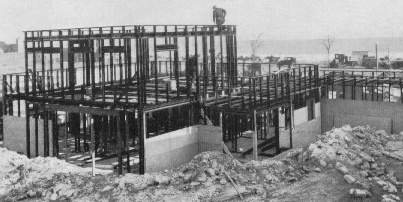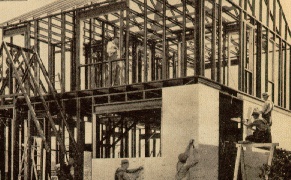The Good Housekeeping Stran-Steel House
Chicago World's
Fair, 1933
Click on an image to see a larger view.
 For architects and
builders, the Stran-Steel home exemplified a triumph in the use of an innovative
building material that, until now, had only been used for skyscrapers and commercial buildings. The
Stran-Steel Corporation produced a lightweight steel beam that was more flexible than wood, lighter
and twice as strong. The frame of the home consisted of these beams in a network of interlocking
joints. Additionally, a key to the steel success as a building material was the use of a specially
designed nail that would penetrate the girders to hold wallboard on both the inside and outside
of the struture. The result was a sturdy and well insulated building that would withstand even the
most severe weather and natural disasters.
For architects and
builders, the Stran-Steel home exemplified a triumph in the use of an innovative
building material that, until now, had only been used for skyscrapers and commercial buildings. The
Stran-Steel Corporation produced a lightweight steel beam that was more flexible than wood, lighter
and twice as strong. The frame of the home consisted of these beams in a network of interlocking
joints. Additionally, a key to the steel success as a building material was the use of a specially
designed nail that would penetrate the girders to hold wallboard on both the inside and outside
of the struture. The result was a sturdy and well insulated building that would withstand even the
most severe weather and natural disasters.
 More
interestingly is the outer
covering that was created by the corporation. To provide a fireproof
surface, eight by two feet sheets of three inch thick baked iron enamel were used to cover the outside.
The baked surface of the material gave the illusion of brick and also helped to insulate the home.
Of course, such an innovative and futuristic building material could only work on an art deco structure
in the 1930's. The Stran-Steel House is a prime example of the deco influence on the artists and
contractors of the day. Incorporating streamlined lines, elegance and technology is a trademark of
the 1933 World's Fair. Many of the buildings that housed exhibits or concert halls personified the
more cubist Bauhaus influence.
More
interestingly is the outer
covering that was created by the corporation. To provide a fireproof
surface, eight by two feet sheets of three inch thick baked iron enamel were used to cover the outside.
The baked surface of the material gave the illusion of brick and also helped to insulate the home.
Of course, such an innovative and futuristic building material could only work on an art deco structure
in the 1930's. The Stran-Steel House is a prime example of the deco influence on the artists and
contractors of the day. Incorporating streamlined lines, elegance and technology is a trademark of
the 1933 World's Fair. Many of the buildings that housed exhibits or concert halls personified the
more cubist Bauhaus influence.
 More
interestingly is the outer
covering that was created by the corporation.
More
interestingly is the outer
covering that was created by the corporation. 